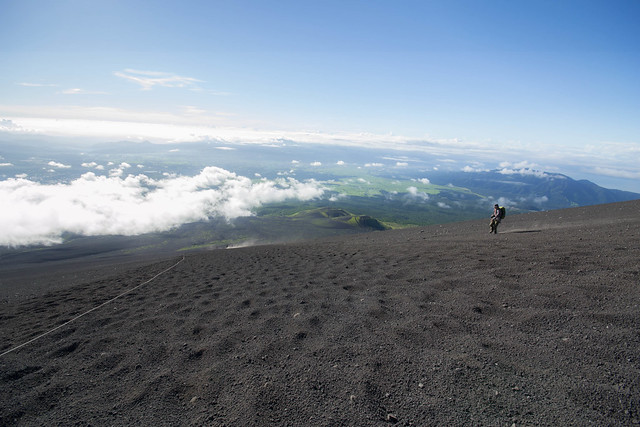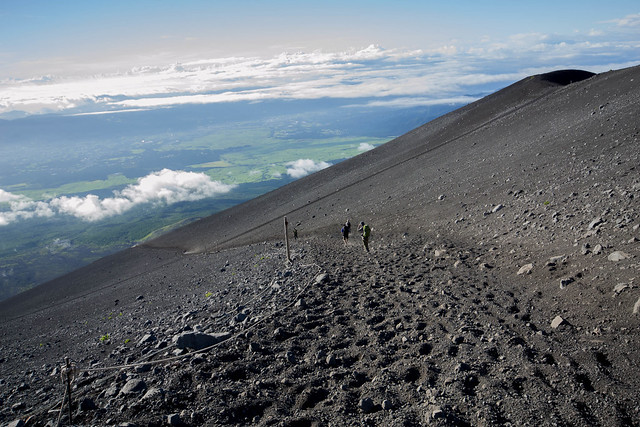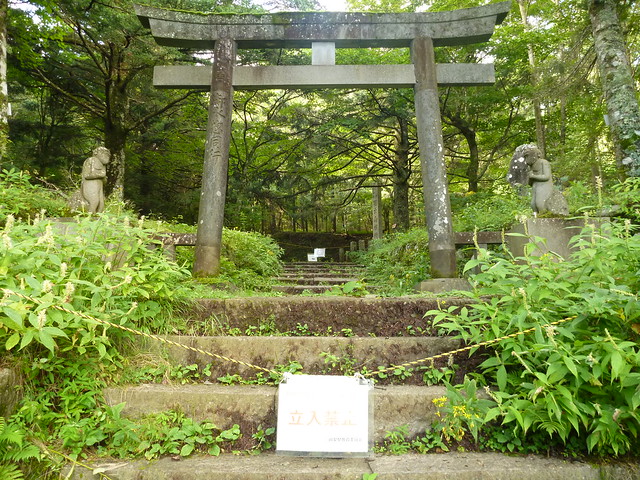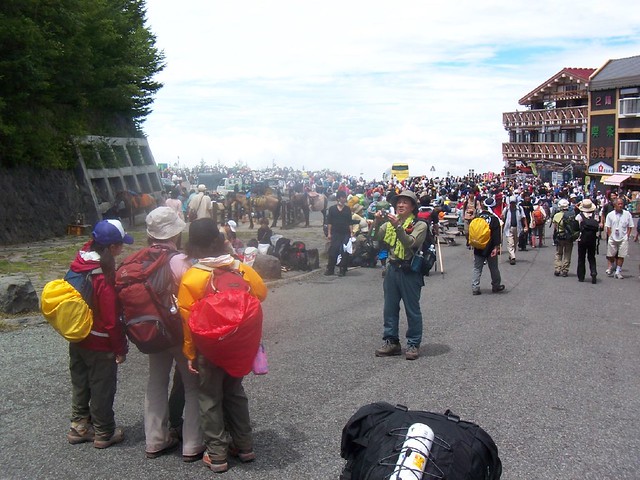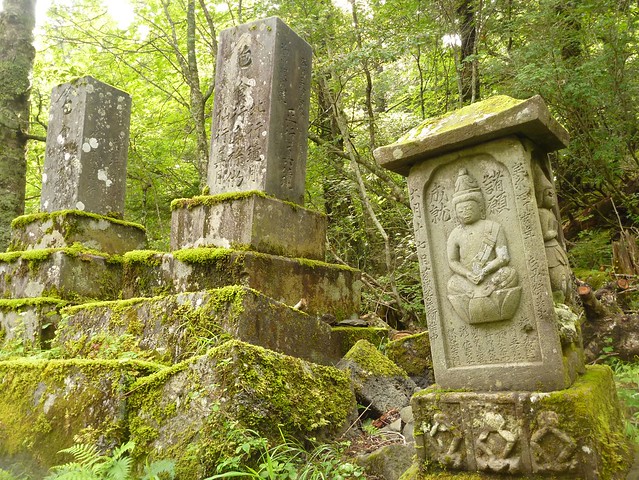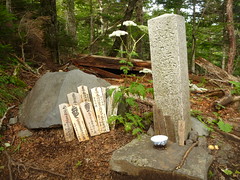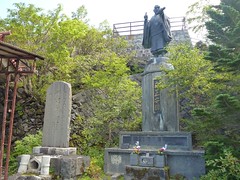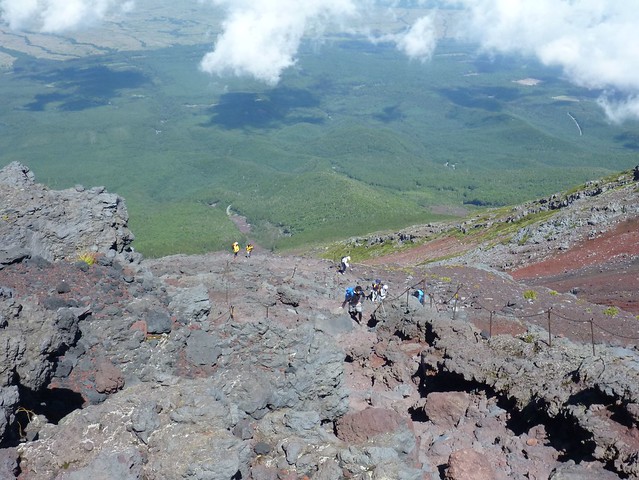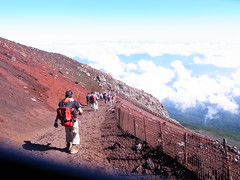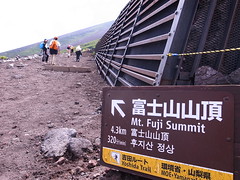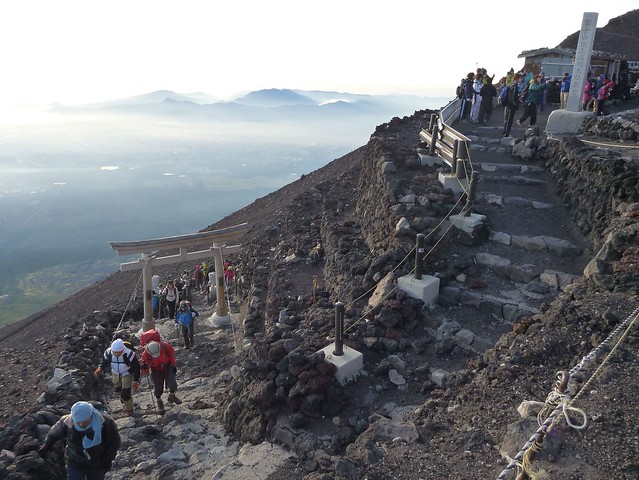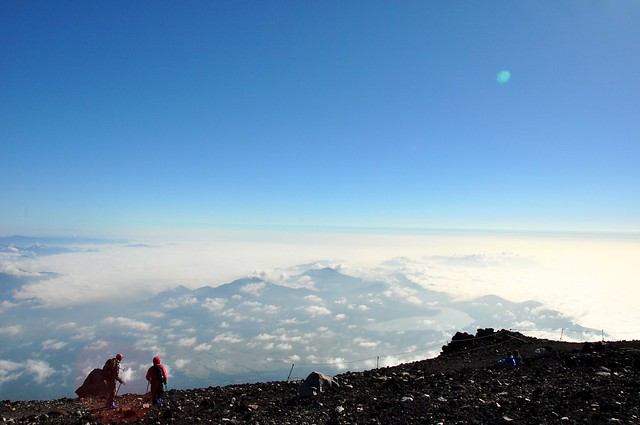The Soma Nomaoi Festival(相馬野馬追) is being held in the Soma area, Fukushima Prefecture from July 27 to 29. It is a festival with a history of over 1,000 years. The festival is said to have originated from a military training by Taira no Masakado(平将門, ?-940).
Samurai cavaliers dressed as if from a period of provincial wars head for a rendezvous point through a national road and rice fields.
Soma Nomaoi Festival:
http://soma-nomaoi.jp/ (Japanese version)
http://soma-nomaoi.jp/english.htm (English version)
broadcast schedule:
http://www.minamisoma.tv/news/detail_130706.html (Japanese version only)
live broadcast (July 28-29):
http://www.minamisoma.tv/channel/live.asx
Three shrines and five villages in the Soma area are taking part in the festival.
The Soma area was damaged by the earthquake and tsunami in 2011. The main venue of the event is the former emergency evacuation preparation zone, and the venue was decontaminated.
Many of horseback riders lost their family members, houses and horses in 2011. Although about 200 of 600 horses were left dead or missing by the tsunami, 430 horses including retired thoroughbred racehorses participate in the festival this year.
The highlight of this festival, armor horse race(甲冑競馬, Kacchu-keiba) and competition for sacred flag(神旗争奪戦, Sinki-sodatsusen), are held on July 28.
Wild horse chasing(野馬懸, Nomagake) will be held on July 29. It's a Shinto ritual that comes from offering captured wild horses.
This blog mainly introduces traditional Japanese things including seasonal events, flowers, confectionery, handicrafts, bunraku(Japanese puppet theater). Short introductions and links to all of my blog posts are shown on four calendar pages on sidebar.
Events:
Cherry Blossom Forecast 2024
https://www.japan-guide.com/sakura/
https://weathernews.jp/sakura/ (Japanese version only)
https://tenki.jp/sakura/expectation/ (Japanese version only)
https://www.otenki.jp/sp/art/sakura/ (Japanese version only)
when and where to see cherry blossoms (Japanese version only):
https://hanami.walkerplus.com/
https://sp.jorudan.co.jp/hanami/
https://www.jalan.net/theme/sakura/
Cherry Blossom Forecast 2024
https://www.japan-guide.com/sakura/
https://weathernews.jp/sakura/ (Japanese version only)
https://tenki.jp/sakura/expectation/ (Japanese version only)
https://www.otenki.jp/sp/art/sakura/ (Japanese version only)
when and where to see cherry blossoms (Japanese version only):
https://hanami.walkerplus.com/
https://sp.jorudan.co.jp/hanami/
https://www.jalan.net/theme/sakura/
Sunday, July 28, 2013
Monday, July 22, 2013
Mount Fuji (5)
After climbing Mt. Fuji, Fuji-ko pilgrims stayed overnight at the foot of the mountain, and performed a tour of Hakkai.
Hakkai includes Soto-hakkai(外八海), Uchi-hakkai(内八海), Moto-hakko(元八湖). Uchi-hakkai means eight lakes including the Fuji Five Lakes around Mt. Fuji. Soto-hakkai means seven lakes and a beach including Lake Biwa, Lake Suwa in wide-ranging areas of Japan. Moto-hakko means Oshino Hakkai(eight springs). It was regarded as an important ascetic training to make pilgrimages to one of them after climbing Mt. Fuji. Soto-hakkai was treated as a special case. Pilgrims went around Uchi-hakkai or Moto-hakko, and performed cold water ablutions at each site.
Lake Motosuko
Lake Yamanakako
In Oshino Village, many villagers died of the great famine that has begun in 1833, and lasted until 1837. A headman of the village planned to take advantage of Fuji-ko to revive the village. He developed eight spring-fed ponds from the springs in the village so that Fuji-ko pilgrims could perform a tour of Hakkai in the village. At each of the eight spring-fed ponds in Oshino, one of the Eight Dragon Kings(Hachidai Ryuo) is enshrined.
Some people say that Mt. fuji is best viewed from the Oshino Village.
However, there are artificial ponds other than the eight spring-fed ponds in the village now. They are misleading. Some people are concerned that they cause environmental damage including declining quality and depletion of the eight spring-fed ponds.
Actually, a water mill in the village draws water from Nigoriike Pond, so it reduced the amount of the pond's water.
The water flowed from Nigoriike Pond to an artificial pond called Nakaike.
This spot abounds in tourists, but it has nothing to do with the eight spring-fed ponds.
Deguchiike Pond is one kilometer away from other spring-fed ponds, so few people visit here.
Shiraito waterfalls
It is said that Hasegawa Kakugyo performed cold water ablutions by Shiraito waterfalls in Fujinomiya City. The waterfall came to be a place for ascetic training.
Kawaguchi Asama-jinja Shrine(河口浅間神社) in Fujikawaguchiko-machi, Yamanashi Prefecture
A theory says that Kawaguchi Asama-jinja Shrine was build in 865 after Fuji's eruption in 864. Along with Yoshida, Kawaguchi was the north base for climbing Mount Fuji. So the village attracted many Fuji-ko pilgrims. There were many oshi lodging house. While Yoshida became very popular among pilgrims in the latter Edo Period, Kawaguchi went into a decline.
Now Kawaguchi Asama-jinja Shrine is a tranquil shrine surrounding the large trees. The shrine has few visitors, but local people esteem it highly. Its chief priest made a small income at the shrine. So he made a living as a judicial scrivener and visited the shrine during a work break.
Now he remains at the shrine during the day because Mount Fuji including this shrine was registered as a World Heritage Site.
Fuji Omuro Segen-jinja Shrine(冨士御室浅間神社) in Fujikawaguchiko-machi, Yamanashi Prefecture
According to legend, the main shrine of the Fuji Omuro Segen-jinja Shrine was build at the 2nd station on Fuji in the early 9th century. Its satomiya shrine (shrine built in village area as a worship space) was built by Lake Kawaguchi in 958. The the current main shrine was built in 1612, and moved to the ground of its satomiya shrine in 1973. The shrine flourished with Shugendo in the middle ages, Fuji-ko in the Edo Period. Many old documents relating to the Takeda clan are stored at the shrine.
Suyama Sengen-jinja Shrine(須山浅間神社) in Susono City, Shizuoka Prefecture
The Suyama route begins at Suyama Sengen-jinja Shrine(須山浅間神社). It is confirmed that the shrine already existed in 1524. Its main shrine and the route were destroyed by a great eruption in 1707. The existing main shrine was rebuilt in 1823.
World Heritage site Mount Fuji includes Suyama route(current Gotenba route) located at an altitude of more than 2050 meters around Suyama Otainai. The route was devastated by a great eruption in 1707. The entire route was restored in 1780.
Nowadays about 5% of Fuji climbers take the Gotenba route in Shizuoka Prefecture. The route includes a long and steep sand hill called o-sunabashiri(大砂走り). Fuji-ko pilgrims used to dash down the hill. Now few climbers take this route. Fuji climbers who run down the hill say, "It's a lot of fun!" Stride length can be 3 meters. However, the hill is too long to run down without stopping. Mt. Fuji last erupted in 1707 from Hoei crater. Fuji climbers can walk on the crater floor.
Fuji Sengen-jinja Shrine (Subashiri Sengen-jinja Shrine) (冨士浅間神社(須走浅間神社)) in Shizuoka Prefecture
The Subashiri route begins at Fuji Sengen-jinja Shrine (Subashiri Sengen-jinja Shrine). Many Fuji-ko pilgrims visited the shrine.
The shrine flourished under the protection of the Takeda clan in the 16th century.This shrine shared the right to pick up coins thrown into the crater as monetary offering with the Fujisan Hongu Sengen Taisha. In the Edo Period, the shrine had a dispute with the Fujisan Hongu Sengen Taisha over the monetary offering. The Tokugawa Shogunate ruled that both shrines split the monetary offering sixty-forty and Fuji Sengen-jinja Shrine managed Yakushi-do (present Kusushi Jinja Shrine) on the Fuji's summit. The Fuji Sengen-jinja Shrine gained 40% of the offering.
The shrine, Subashiri Village near the shrine and the route were devastated by a great eruption in 1707. The village had volcanic tephra 3 meters deep. In the village, 37 houses were burned down, and 36 houses and three temples collapsed. The shrine was heavily damaged, its torii gate was half-buried in volcanic tephra. Its main shrine was almost buried, and only its roof was visible. The route was restored in 1708, and the shrine was rebuilt in 1718. The shrine and route regained Fuji-ko pilgrims.
Kusushi Jinja Shrine is current Okumiya (interior shrine) of the Fujisan Hongu Sengen-taisha Shrine.
World Heritage site Mount Fuji includes Subashiri route(須走口登山道, Subashiriguchi climbing trail) above the fifth station.
About 11% of Fuji climbers take the Subashiri route in Shizuoka Prefecture. Subashiriguchi climbing trail merges with Yoshidaguchi climbing trail at the Mt. Fuji 8th Station. Kakebotoke inscribed with the year 1384 was excavated from the route. Kakebotoke is a round copper plaque with a Buddhist figure for hanging. Although Subashiriguchi climbing trail was also devastated by a great eruption in 1707, it was restored with assistance provided by the Tokugawa Shogunate in 1708.
My grandfather climbed from the foot of Mt. Fuji by taking the Subashiri route long before World War II.
Subashiri route
Mount Fuji has been worshipped and loved by the Japanese people since ancient times and has long attracted artists. The first poem featuring Fuji that comes to my mind is a waka poem written by Yamabe no Akahito around the early eighth century.
The Mihonomatsubara pine tree grove(三保の松原) was added to the World Heritage List as part of the Fujisan Cultural Site. The grove was listed as a source of artistic inspiration. There was little hope that the pine groves was added to the list. Because it is 45km away from Mt.Fuji. That was a come-from-behind victory.
Hakkai includes Soto-hakkai(外八海), Uchi-hakkai(内八海), Moto-hakko(元八湖). Uchi-hakkai means eight lakes including the Fuji Five Lakes around Mt. Fuji. Soto-hakkai means seven lakes and a beach including Lake Biwa, Lake Suwa in wide-ranging areas of Japan. Moto-hakko means Oshino Hakkai(eight springs). It was regarded as an important ascetic training to make pilgrimages to one of them after climbing Mt. Fuji. Soto-hakkai was treated as a special case. Pilgrims went around Uchi-hakkai or Moto-hakko, and performed cold water ablutions at each site.
Lake Motosuko
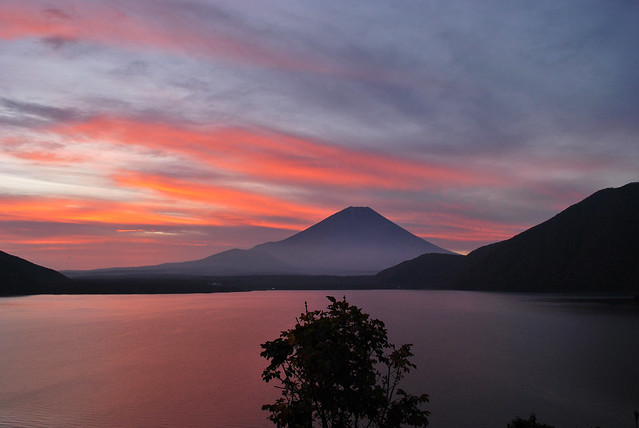 |
| 秋、早朝、本栖湖、富士山! by Mt.Fuji early morning, November 02 by [puamelia] /flickr |
Lake Yamanakako
 |
| 山中湖と富士山 by ucb /flickr |
In Oshino Village, many villagers died of the great famine that has begun in 1833, and lasted until 1837. A headman of the village planned to take advantage of Fuji-ko to revive the village. He developed eight spring-fed ponds from the springs in the village so that Fuji-ko pilgrims could perform a tour of Hakkai in the village. At each of the eight spring-fed ponds in Oshino, one of the Eight Dragon Kings(Hachidai Ryuo) is enshrined.
Some people say that Mt. fuji is best viewed from the Oshino Village.
However, there are artificial ponds other than the eight spring-fed ponds in the village now. They are misleading. Some people are concerned that they cause environmental damage including declining quality and depletion of the eight spring-fed ponds.
Actually, a water mill in the village draws water from Nigoriike Pond, so it reduced the amount of the pond's water.
 |
| photo by 高画質壁紙写真集無料壁紙 |
The water flowed from Nigoriike Pond to an artificial pond called Nakaike.
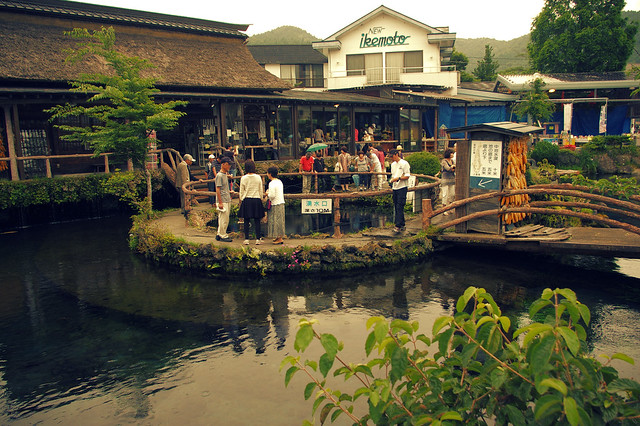 |
| Lake Kawaguchi by kwkd /flickr Nakaike |
This spot abounds in tourists, but it has nothing to do with the eight spring-fed ponds.
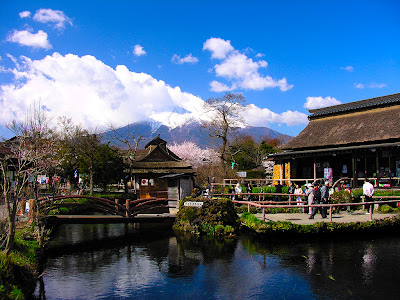 |
| photo by 高画質壁紙写真集無料壁紙 |
Deguchiike Pond is one kilometer away from other spring-fed ponds, so few people visit here.
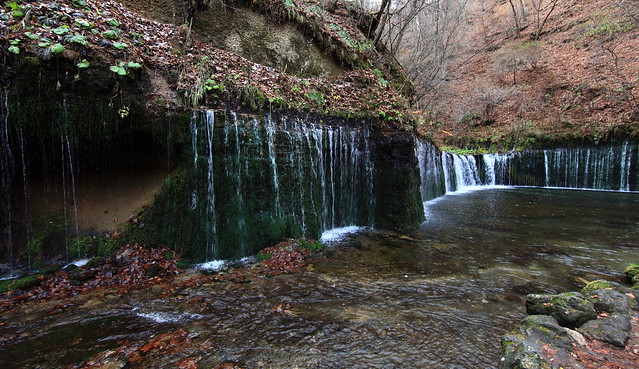 |
Waterfall / 白糸の滝(しらいとのたき) by TANAKA Juuyoh (田中十洋) /flickr
|
Shiraito waterfalls
It is said that Hasegawa Kakugyo performed cold water ablutions by Shiraito waterfalls in Fujinomiya City. The waterfall came to be a place for ascetic training.
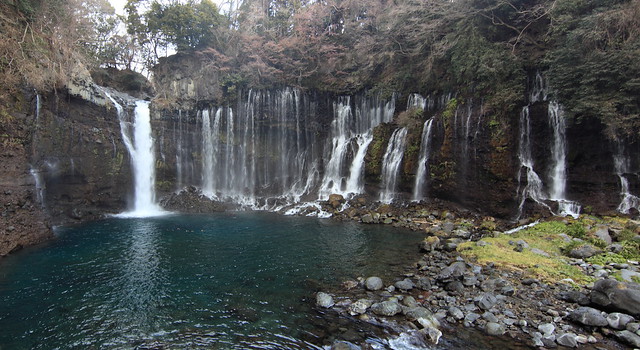 |
Waterfall / 白糸の滝(しらいとのたき) by TANAKA Juuyoh (田中十洋) /flickr
|
Kawaguchi Asama-jinja Shrine(河口浅間神社) in Fujikawaguchiko-machi, Yamanashi Prefecture
A theory says that Kawaguchi Asama-jinja Shrine was build in 865 after Fuji's eruption in 864. Along with Yoshida, Kawaguchi was the north base for climbing Mount Fuji. So the village attracted many Fuji-ko pilgrims. There were many oshi lodging house. While Yoshida became very popular among pilgrims in the latter Edo Period, Kawaguchi went into a decline.
Now Kawaguchi Asama-jinja Shrine is a tranquil shrine surrounding the large trees. The shrine has few visitors, but local people esteem it highly. Its chief priest made a small income at the shrine. So he made a living as a judicial scrivener and visited the shrine during a work break.
Now he remains at the shrine during the day because Mount Fuji including this shrine was registered as a World Heritage Site.
Fuji Omuro Segen-jinja Shrine(冨士御室浅間神社) in Fujikawaguchiko-machi, Yamanashi Prefecture
According to legend, the main shrine of the Fuji Omuro Segen-jinja Shrine was build at the 2nd station on Fuji in the early 9th century. Its satomiya shrine (shrine built in village area as a worship space) was built by Lake Kawaguchi in 958. The the current main shrine was built in 1612, and moved to the ground of its satomiya shrine in 1973. The shrine flourished with Shugendo in the middle ages, Fuji-ko in the Edo Period. Many old documents relating to the Takeda clan are stored at the shrine.
 |
| main shrine of Fuji Omuro Segen-jinja Shrine photo by 列島宝物館 |
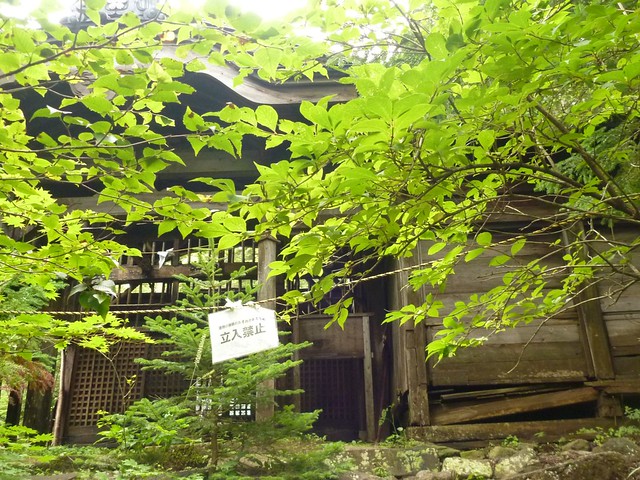 |
| 富士山御室浅間神社, 一合目から富士山に登るClimbing Mt.fuji, from the starting point of Yoshidaguchi Climb Trail by jetalone /flickr |
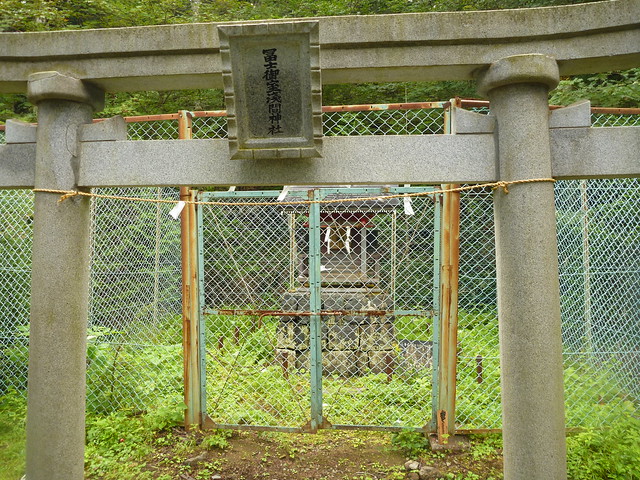 |
富士山御室浅間神社,一合目から富士山に登る Climbing Mt.fuji, from the starting point of Yoshidaguchi Climb Trail
by jetalone /flickr |
Suyama Sengen-jinja Shrine(須山浅間神社) in Susono City, Shizuoka Prefecture
The Suyama route begins at Suyama Sengen-jinja Shrine(須山浅間神社). It is confirmed that the shrine already existed in 1524. Its main shrine and the route were destroyed by a great eruption in 1707. The existing main shrine was rebuilt in 1823.
World Heritage site Mount Fuji includes Suyama route(current Gotenba route) located at an altitude of more than 2050 meters around Suyama Otainai. The route was devastated by a great eruption in 1707. The entire route was restored in 1780.
Nowadays about 5% of Fuji climbers take the Gotenba route in Shizuoka Prefecture. The route includes a long and steep sand hill called o-sunabashiri(大砂走り). Fuji-ko pilgrims used to dash down the hill. Now few climbers take this route. Fuji climbers who run down the hill say, "It's a lot of fun!" Stride length can be 3 meters. However, the hill is too long to run down without stopping. Mt. Fuji last erupted in 1707 from Hoei crater. Fuji climbers can walk on the crater floor.
 |
| Mt. Fuji (Gotemba Route) by Hyougushi /flickr |
O-sunabashiri
O-sunabashiri, and Hoei crater pictured right.
Fuji Sengen-jinja Shrine (Subashiri Sengen-jinja Shrine) (冨士浅間神社(須走浅間神社)) in Shizuoka Prefecture
The Subashiri route begins at Fuji Sengen-jinja Shrine (Subashiri Sengen-jinja Shrine). Many Fuji-ko pilgrims visited the shrine.
The shrine flourished under the protection of the Takeda clan in the 16th century.This shrine shared the right to pick up coins thrown into the crater as monetary offering with the Fujisan Hongu Sengen Taisha. In the Edo Period, the shrine had a dispute with the Fujisan Hongu Sengen Taisha over the monetary offering. The Tokugawa Shogunate ruled that both shrines split the monetary offering sixty-forty and Fuji Sengen-jinja Shrine managed Yakushi-do (present Kusushi Jinja Shrine) on the Fuji's summit. The Fuji Sengen-jinja Shrine gained 40% of the offering.
The shrine, Subashiri Village near the shrine and the route were devastated by a great eruption in 1707. The village had volcanic tephra 3 meters deep. In the village, 37 houses were burned down, and 36 houses and three temples collapsed. The shrine was heavily damaged, its torii gate was half-buried in volcanic tephra. Its main shrine was almost buried, and only its roof was visible. The route was restored in 1708, and the shrine was rebuilt in 1718. The shrine and route regained Fuji-ko pilgrims.
Kusushi Jinja Shrine is current Okumiya (interior shrine) of the Fujisan Hongu Sengen-taisha Shrine.
World Heritage site Mount Fuji includes Subashiri route(須走口登山道, Subashiriguchi climbing trail) above the fifth station.
About 11% of Fuji climbers take the Subashiri route in Shizuoka Prefecture. Subashiriguchi climbing trail merges with Yoshidaguchi climbing trail at the Mt. Fuji 8th Station. Kakebotoke inscribed with the year 1384 was excavated from the route. Kakebotoke is a round copper plaque with a Buddhist figure for hanging. Although Subashiriguchi climbing trail was also devastated by a great eruption in 1707, it was restored with assistance provided by the Tokugawa Shogunate in 1708.
My grandfather climbed from the foot of Mt. Fuji by taking the Subashiri route long before World War II.
Subashiri route
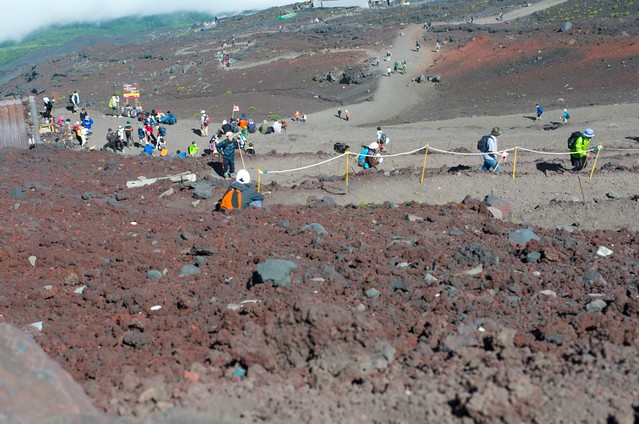 |
| 須走口登山道 by masahiko /flickr |
Mount Fuji has been worshipped and loved by the Japanese people since ancient times and has long attracted artists. The first poem featuring Fuji that comes to my mind is a waka poem written by Yamabe no Akahito around the early eighth century.
The Mihonomatsubara pine tree grove(三保の松原) was added to the World Heritage List as part of the Fujisan Cultural Site. The grove was listed as a source of artistic inspiration. There was little hope that the pine groves was added to the list. Because it is 45km away from Mt.Fuji. That was a come-from-behind victory.
 |
| The Miho no Matsubara pine forest is seen against the backdrop of the dim shape of Mt. Fuji. photo by 日本列島お国自慢 |
 | |
|
Sunday, July 21, 2013
Mount Fuji (4)
Hasegawa Kakugyo(長谷川角行, 1541-1646) was a practitioner of Shugendo and visited various ascetic sites. Later he started to go through hard training as a Mt. Fuji worshipper in a lava cave called Hitoana(人穴) at the west foot of Mt. Fuji. He is said to be the founder of Fuji-ko(富士講), Mt.Fuji faith. Ko(講) is a group of people professing the same religion.
Hitoana Fuji-ko Iseki(人穴富士講遺跡) in Fujinomiya City is a a holy site of Fuji-ko where about 230 monuments remain. Fuji-ko worshippers build the monuments in honor of Kakugyo and another worshippers, in commemoration of reaching the summit. Now the cave is off-limits to visitors.
His followers, Murakami Kosei(村上光清, 1682-1759) and Jikigyo Miroku(食行身禄, 1671-1733), activated Fuji-ko after his death.
Kitaguchi Hongu Fuji Sengen Shrine(北口本宮冨士浅間神社) in Fujiyoshida City
It is confirmed that there were already the shrine's gate(trii) in 1480, and the shrine buildings in the mid 16th century. Murakami Kosei put in his own money to restore the shrine buildings at great cost in the 1730s.
The Yoshida Fire Festival(吉田の火祭り, Yoshida no Himatsuri) is held on August 26 by Kitaguchi Hongu Fuji Sengen Shrine and its auxiliary shrine. Mt. Fuji climbing season ends on the day.
Kitaguchi Hongu Fuji Sengen Shrine
In a cave, Jikigyo Miroku practiced fasting, went into a meditative state, and died in 1733. It's the practice called Nyujo causing one's own deaths in a way that results in mummification. His Nyujo was reported sensationally by kawaraban in Edo(current Tokyo), and his name became widely known to the public. Kawaraban is a single-sheet newspaper printed by means of woodblock printing. They are very much like tabloid papers, and peddlers sold the papers while delivering sales pitch on a street corner.
Believers in Mt. Fuji faith increased rapidly in number.
One of his followers founded a Ko(講) three years after his death. He built an artificial mound named Fujizuka(miniature of Mt. Fuji) on the present-day Waseda University campus in Tokyo in 1779. The mound was moved to the site about 400 meters away from the campus in 1965.
In the Edo Period, it was not easy for worshippers to climb Mt. Fuji. Fujizuka mounds were designed to allow those who couldn't visit Mt. Fuji to simulate the pilgrimage to Mt. Fuji. Many fujizuka mounds still exist in Japan.
Commoners were prohibited from moving freely across Japan in the Edo Period, but only religious pilgrimage was allowed. However, the cost of the pilgrimage was comparable with a farmer's annual income. Members of Ko(講) put aside some money on a regular basis for the pilgrimage and chose delegates as pilgrims.
In the 1830s, 4.8 million people, which accounted for a sixth part of the total population in Japan, made pilgrimages to Ise Jingu. It was due to the outstanding performance of onshi(御師) belonging to Ise Jingu Shrine. People called onshi(or oshi) belonged to temples or shrines, guided worshippers through the temples or shrines, and arranged accommodations for worshippers like travel agencies. Onshi from Ise travelled all over the country and encouraged people to make a pilgrimage to the shrine.
For more information about Onshi belonging to Ise Jingu at http://ichinen-fourseasonsinjapan.blogspot.jp/2010/06/ise-ondo-koi-no-netaba.html
In the late Edo period, multitudinous Fuji-ko were founded and flourished. Even now, about 70 Fuji-ko groups are active. Each pilgrim in white clothing and a sedge hat climbed the mountain with a big walking stick while chanting the phrase“Rokkon Shojo" (六根清浄, purification of the six roots of perception). The six roots of perception are the eye(sight), the ear(hearing), the tongue(taste), the nose(smell), the body(touch), and the mind.
present-day Fuji-ko pilgrims
Umagaeshi(馬返) at 1,450 meter elevation
Mt. Fuji worshippers used to purify themselves here.
2nd station on Yoshida route
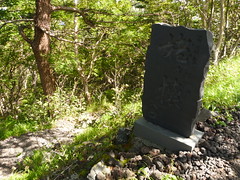
姥ヶ懐, 一合目から富士山に登る Climbing Mt.fuji, from the starting point of Yoshidaguchi Climb Trail
by jetalone /flickr
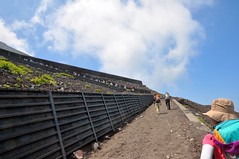
富士山登山2010 (Mt. Fuji Climb) by imgdive /flickr
at the end of the Yoshida route
Kengamine Peak- the real peak of Mt.Fuji
Kengamine Peak and Konoshiroike Pond
former Mt. Fuji Weather Station on Kengamine Peak
Dainichidake Peak(Asahidake Peak)
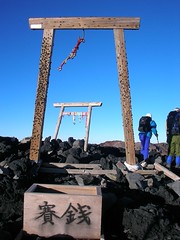
Mt.Fuji Ohachi-meguri 大日岳(朝日岳, 富士山お鉢めぐり) by jetalone /flickr
Hitoana Fuji-ko Iseki(人穴富士講遺跡) in Fujinomiya City is a a holy site of Fuji-ko where about 230 monuments remain. Fuji-ko worshippers build the monuments in honor of Kakugyo and another worshippers, in commemoration of reaching the summit. Now the cave is off-limits to visitors.
His followers, Murakami Kosei(村上光清, 1682-1759) and Jikigyo Miroku(食行身禄, 1671-1733), activated Fuji-ko after his death.
Kitaguchi Hongu Fuji Sengen Shrine(北口本宮冨士浅間神社) in Fujiyoshida City
It is confirmed that there were already the shrine's gate(trii) in 1480, and the shrine buildings in the mid 16th century. Murakami Kosei put in his own money to restore the shrine buildings at great cost in the 1730s.
The Yoshida Fire Festival(吉田の火祭り, Yoshida no Himatsuri) is held on August 26 by Kitaguchi Hongu Fuji Sengen Shrine and its auxiliary shrine. Mt. Fuji climbing season ends on the day.
Kitaguchi Hongu Fuji Sengen Shrine
 |
| GR002383 by Zengame /flickr |
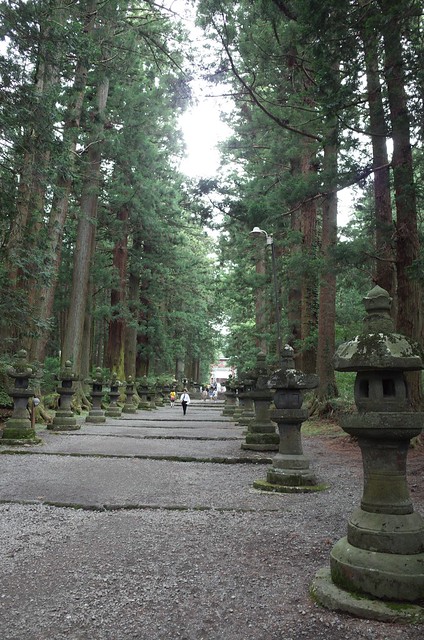 |
| GR002325 by Zengame /flickr |
 |
| Kitaguchi Hongu Fuji Sengen Jinja. by Simon le nippon /flickr |
 |
| DSC_4412 by Simon le nippon /flickr |
 |
| Fuji Sengen Shrine, Mt. Fuji by eyeonjapan.com /flickr |
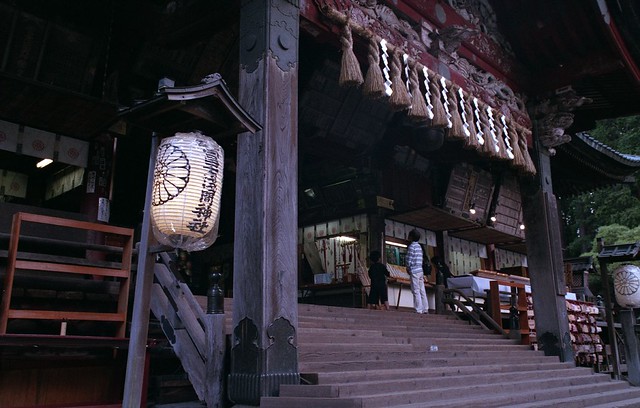 |
| 富士浅間神社 - Fuji Sengen Jinja shrine by hogeasdf /flickr |
In a cave, Jikigyo Miroku practiced fasting, went into a meditative state, and died in 1733. It's the practice called Nyujo causing one's own deaths in a way that results in mummification. His Nyujo was reported sensationally by kawaraban in Edo(current Tokyo), and his name became widely known to the public. Kawaraban is a single-sheet newspaper printed by means of woodblock printing. They are very much like tabloid papers, and peddlers sold the papers while delivering sales pitch on a street corner.
One of his followers founded a Ko(講) three years after his death. He built an artificial mound named Fujizuka(miniature of Mt. Fuji) on the present-day Waseda University campus in Tokyo in 1779. The mound was moved to the site about 400 meters away from the campus in 1965.
In the Edo Period, it was not easy for worshippers to climb Mt. Fuji. Fujizuka mounds were designed to allow those who couldn't visit Mt. Fuji to simulate the pilgrimage to Mt. Fuji. Many fujizuka mounds still exist in Japan.
Commoners were prohibited from moving freely across Japan in the Edo Period, but only religious pilgrimage was allowed. However, the cost of the pilgrimage was comparable with a farmer's annual income. Members of Ko(講) put aside some money on a regular basis for the pilgrimage and chose delegates as pilgrims.
For more information about Onshi belonging to Ise Jingu at http://ichinen-fourseasonsinjapan.blogspot.jp/2010/06/ise-ondo-koi-no-netaba.html
In the late Edo period, multitudinous Fuji-ko were founded and flourished. Even now, about 70 Fuji-ko groups are active. Each pilgrim in white clothing and a sedge hat climbed the mountain with a big walking stick while chanting the phrase“Rokkon Shojo" (六根清浄, purification of the six roots of perception). The six roots of perception are the eye(sight), the ear(hearing), the tongue(taste), the nose(smell), the body(touch), and the mind.
present-day Fuji-ko pilgrims
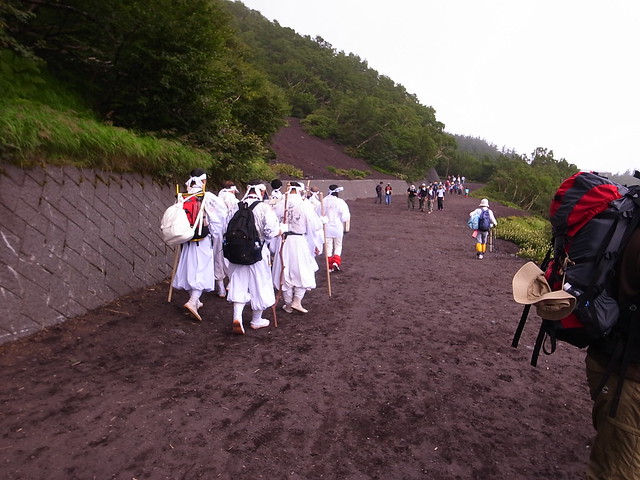 |
| 富士山登山(吉田ルート) Climb Mt.Fuji(Yoshida Route) by jetalone /flickr |
Most pilgrims climbed up Mt. Fuji from the relatively gentle Yoshida route, offered prayers at the mountain's top, and went down to Gotenba through a long and steep sand hill called sunabashiri(砂走り). This route became popular, as Miroku set down the Yoshida route as the main climbing route.
Most Fuji-ko pilgrims lodged in oshi houses in Kamiyoshida. At peak, there were about 90 oshi lodging houses in Kamiyoshida which was the starting point of the Yoshida route.
Each oshi lodging house had a shrine, a large hall for lodging, a large kitchen, and a waterfall for purifying oneself. Konohayasakuya-hime was enshrined in the shrine, oshi in a priest's garb recited prayers.Nowadays there are about 40 oshi in Kamiyoshida.
Oshi houses were open for only two months during the Mt. Fuji climbing season. After the season ended, oshi travelled all over the country and were engaged in missionary work. They visited parishioners for reciting prayers, exorcising evil spirits, and giving talismans every year.
Fuji-ko pilgrims climbed Fuji from the Yoshida route after visiting Kitaguchi Hongu Fuji Sengen Shrine. Oshi didn't climb Mt. Fuji and sent pilgrims off. People called Sendatsu led them to the top of Mt. Fuji. Porters carried their food, cold protection clothes up the mountain.
Three Shinto priests of Kitaguchi Hongu Fuji Sengen Shrine are also oshi. Fuji-ko declined after the profession of onshi was abolished in 1871. Now only two oshi lodging houses have kept the business running in Kamiyoshida, and oshi don't visit parishioners in winter. About 70 Fuji-ko groups are still active. They climb Mt. Fuji in summer, but most of them rest at oshi lodging houses without staying overnight.
 |
house of the Osano Family photo by 列島宝物館 |
World Heritage site Mount Fuji includes two oshi's houses which Oshi's family lived in, and pilgrims stayed at.
The former house of the Togawa Family, 旧外川家住宅) is open to the public, but the house of the Osano Family(小佐野家住宅) is closed.
On the day before Mount Fuji climbing, Fuji-ko pilgrims visited Funatsu and Yoshida lava tree molds, and purified themselves by passing through the caves. Fuji-ko worshippers attached a great importance to the two caves because both of them were near the Yoshidaguchi climbing trail.
Hasegawa Kakugyo discovered a lava cave at the north foot of Mt. Fuji in 1612 when he climbed the mountain. He enshrined Asama no Okami, the deity of Mt. Fuji, in the cave.
Funatsu lava tree molds(船津胎内樹型, Funatsu Tainai Jukei) in Fujikawaguchiko-machi, Yamanashi Prefecture were discovered by a Fuji-ko worshipper in 1673. Yoshida lava tree molds(吉田胎内樹型, Yoshida Tainai Jukei) in Fujiyoshida City, Yamanashi Prefecture were developed as a holy site in 1892. They are interconnected lava molds. A lava flow coated littered fallen trees and burned the insides out leaving interconnected lava molds around the trees. Funatsu tree-mold cave is 68 meters long. Yoshida tree-mold cave is 61 meters long. They have branching smaller caverns. Yoshida Tainai and more than 60 tree molds scattering in this area, are designated as a natural monument in Japan.
Tainai(胎内) means the interior of the womb. The caves are called Tainai from its resemblance to the human rib cage or the womb of a mother. In Fuji faith, one can be transformed by passing through the cave. Now Yoshida tree-mold cave is normally closed, but it's open to the public on April 29 when Oshi hold Tainai-sai(Tainai Festival). Visitors can enter the cave after a shrine ritual takes place to pray for minimizing damage from volcanic eruptions.
The World Heritage site Mount Fuji includes Yoshida route. This route became popular, as Miroku set down the Yoshida route as the main climbing route. Even now, about 60% of Fuji climbers take Yoshida route(Yoshidaguchi climbing trail) in Yamanashi Prefecture.
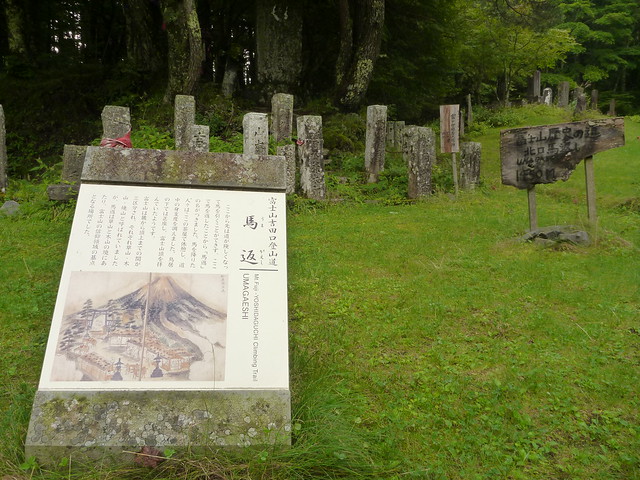 |
| 馬返, 一合目から富士山に登る Climbing Mt.fuji, from the starting point of Yoshidaguchi Climb Trail by jetalone /flickr |
Umagaeshi(馬返) at 1,450 meter elevation
Horses were not able to climb up Fuji from here, so climbers had them go back.
Mt. Fuji worshippers used to purify themselves here.
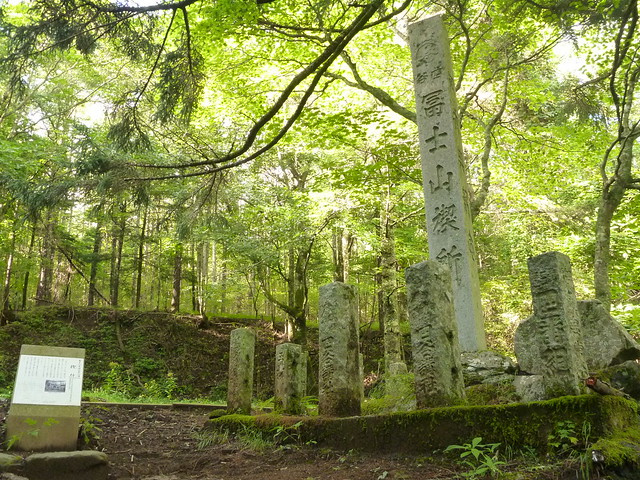 |
| 富士山禊所跡, 一合目から富士山に登る Climbing Mt.fuji, from the starting point of Yoshidaguchi Climb Trail by jetalone /flickr |
The Kawaguchikoguchi climbing trail starting from Mt. Fuji 5th Station(Fuji-Subaru Line 5th Station) merges with Yoshidaguchi climbing trail at the Mt. Fuji 6th Station.
2nd station on Yoshida route
4th station on Yoshida route
5th station on Yoshida route
Buddhist monk Nichiren's statue
5th station on Yoshida route

姥ヶ懐, 一合目から富士山に登る Climbing Mt.fuji, from the starting point of Yoshidaguchi Climb Trail
by jetalone /flickr
9th station on Yoshida and Subashiri routes

富士山登山2010 (Mt. Fuji Climb) by imgdive /flickr
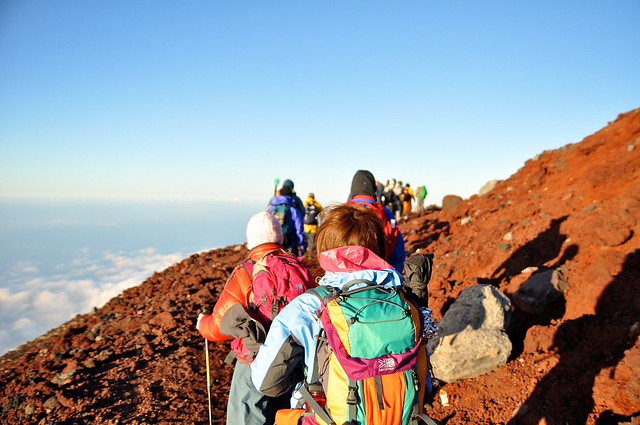 |
| 富士山登山2010 (Mt. Fuji Climb) by imgdive /flickr |
4.3 kilometers to the summit
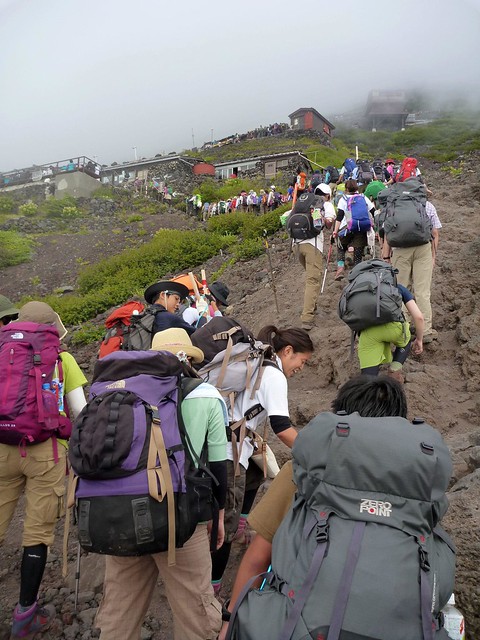 |
| 富士山登山(援人やま部) Mt.Fuji Trekking 2012 by jetalone /flickr |
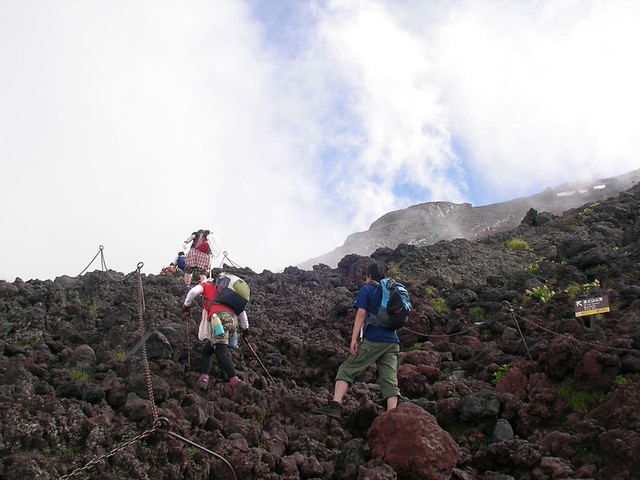 |
| 富士山登山2009 Climbing Mt.Fuji by jetalone /flickr |
at the end of the Yoshida route
Fuji-ko pilgrims walked around the edge of Fuji's summit crater. It's called Ohachimeguri(お鉢めぐり). It take about an hour and half to go around the crater.
;
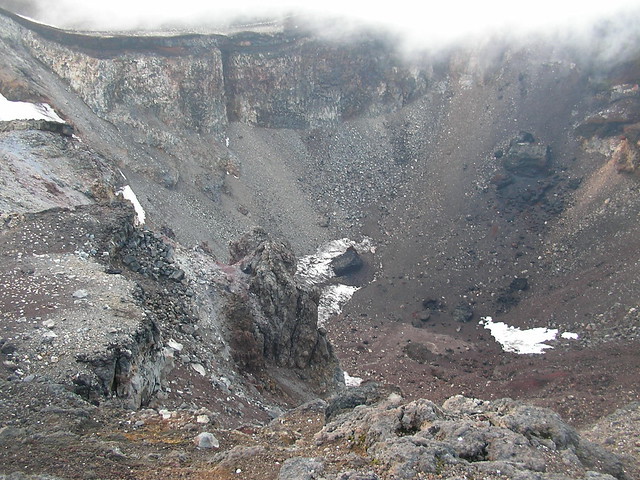 |
| 富士山の火口, 富士山登山(富士宮ルート) Climbing Mt.Fuji by jetalone /flickr |
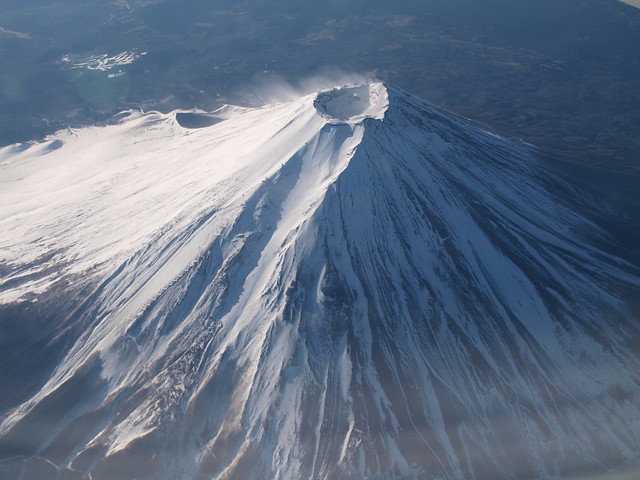 |
| P1023494 by shishamo72 /flickr |
Kengamine Peak- the real peak of Mt.Fuji
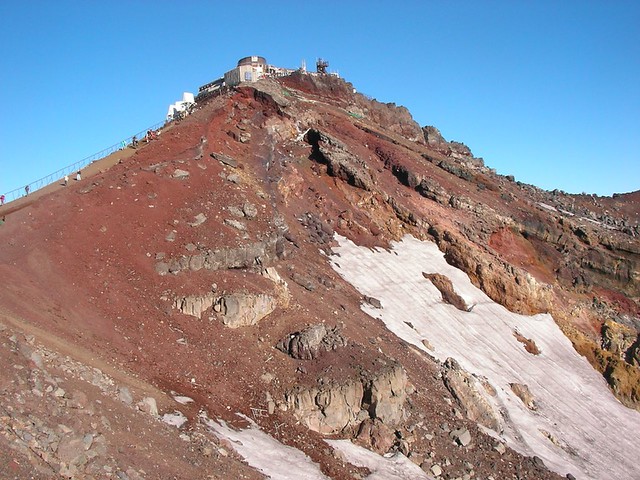 |
| 剣が峰・富士山測候所(富士山お鉢めぐり) Mt.Fuji Ohachi-meguri by jetalone /flickr |
Kengamine Peak and Konoshiroike Pond
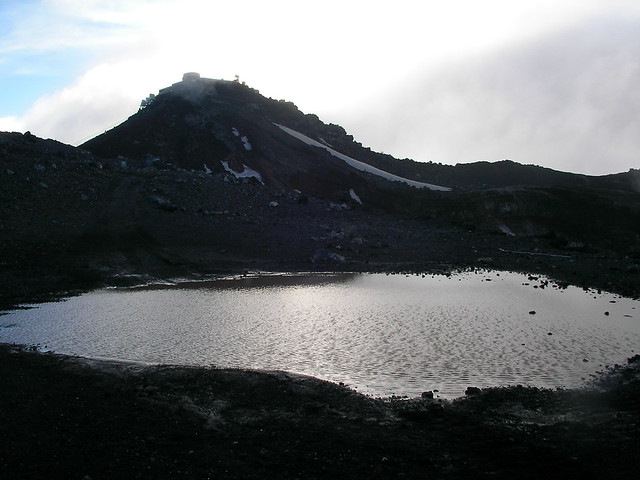 |
| 剣が峰と鰶(このしろ)池, 富士山登山(富士宮ルート) Climbing Mt.Fuji by jetalone /flickr |
former Mt. Fuji Weather Station on Kengamine Peak
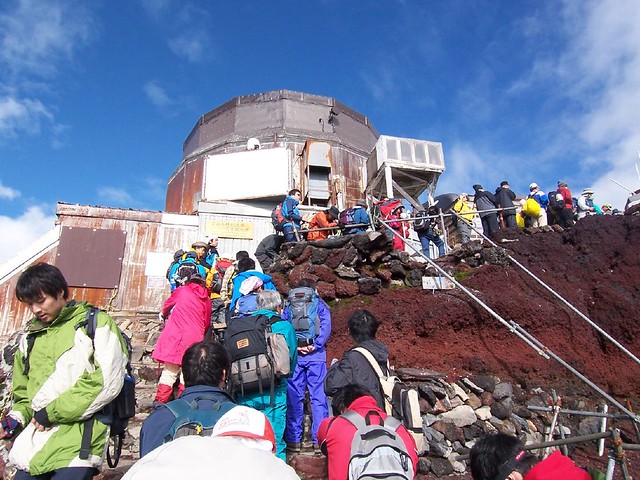 |
| 日本最高地点 剣が峰(富士山お鉢めぐり) Climbing Mt.Fuji by jetalone /flickr |
Dainichidake Peak(Asahidake Peak)

Mt.Fuji Ohachi-meguri 大日岳(朝日岳, 富士山お鉢めぐり) by jetalone /flickr
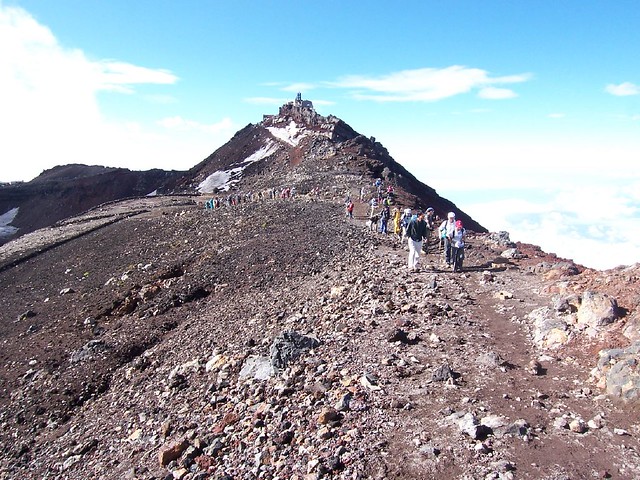 |
| 富士山お鉢めぐり(富士山登山2009) Climbing Mt.Fuji by jetalone /flickr |
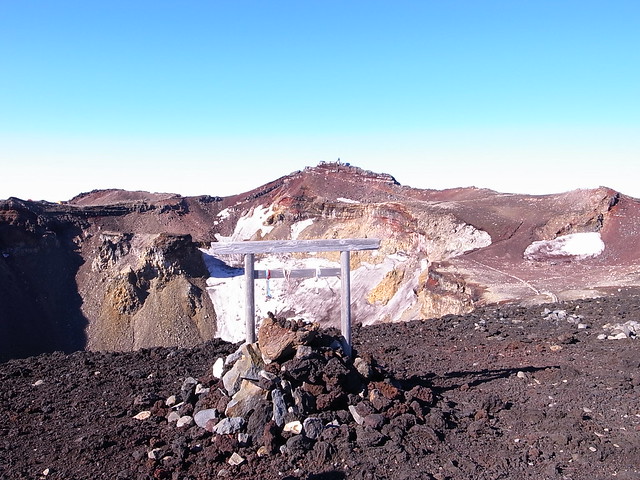 |
| お鉢めぐり, 富士山登山(吉田ルート) Climb Mt.Fuji(Yoshida Trail) by jetalone /flickr |
Subscribe to:
Posts (Atom)
